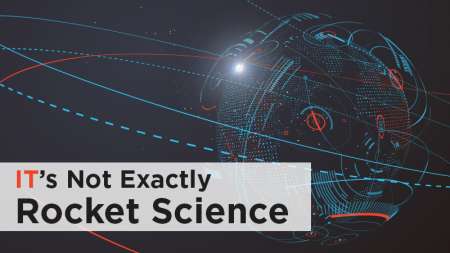The benefits of Software Defined Everything (SDE) – in which a physical infrastructure is virtualized and delivered as services on demand – will change the way we design, build, and test new applications. In a virtual environment, operational costs drop precipitously as the pace of innovation accelerates. Containerization – a way to virtually run separate […]
It’s hard to know for certain what the U.S. economy will look like in 10 years’ time, much less what the work day will look like. One thing we do know: As younger generations enter the workforce, they will bring new habits, technology, conventions, and expectations that will likely transform business and government. With the […]
The Pentagon wants to make ordering up a space launch as easy as hailing an Uber. […]
Artificial intelligence (AI) machines can out-think humans when it comes to a lot of complex, fine-grained tasks, such as detecting signs of cancer more accurately than doctors can, or finding exoplanets based on “dimming effect” data from distant solar systems. But what they don’t have is good old common sense, the ability to apply its knowledge, and the experience to various tasks humans can do from childhood. […]
Before we can have a rational discussion about artificial intelligence (AI), we should probably cut through the hysteria surrounding it. Contrary to popular opinion, we’re not talking about machines that are going to rise up, steal our jobs, and render humans obsolete. […]
Our lives are very different today than they were even 15 years ago. We walk around with computers in our pockets and do things like share our locations with loved ones via satellite technology. Still, the changes we’ve experienced so far are nothing compared to the tech tidal wave that’s approaching. […]
Federal cloud services contracts are projected to hit $6.5 billion in fiscal year 2018, an increase of 32 percent over FY2017, according to an analysis by Bloomberg Government. […]
Welcome to MeriTalk News Briefs, where we bring you all the day’s action that didn’t quite make the headlines. No need to shout about ‘em, but we do feel that they merit talk. […]
The Federal workforce of the future will most likely consist of supervisors, the human workforce, contractors, and a new kind of worker–the digital employee that is equipped to reduce the burden of repetitive, simple tasks on humans. […]
Welcome to MeriTalk News Briefs, where we bring you all the day’s action that didn’t quite make the headlines. No need to shout about ‘em, but we do feel that they merit talk. […]
The Government Accountability Office (GAO) released a report today that says Federal agencies are largely following guidelines to make Freedom of Information Act (FOIA) requests easier to access by making many of the frequently requested documents available online. […]
Air Force Gen. John Hyten, commander of the United States Strategic Command, told House members today that he would be happy to give over the Air Force’s role in providing “situational space awareness (SSA)” services which involve keeping track of many thousands of pieces of orbital debris that have the potential to disrupt satellites and the communications and other critical services they provide. […]
Inventions that are crafted and patented in Federal laboratories are having a difficult time finding their way into use in the private sector, according to a report released Monday by the Government Accountability Office (GAO). […]
The National Aeronautics and Space Administration’s (NASA) Jet Propulsion Laboratory (JPL) isn’t just looking into rockets these days. […]
The Federal Risk and Authorization Management Program (FedRAMP) of the General Services Administration (GSA) on Wednesday announced the winners of the inaugural FedRAMP Five Awards at ATARC’s Cloud & Data Center Summit. […]
A new report from the Government Accountability Office (GAO) this week raises concerns that the National Aeronautics and Space Administration (NASA) isn’t properly protecting its IT systems. The agency spends about $1.5 billion annually on IT investments to support its missions. […]
Despite an air of uncertainty coming from the Trump administration, the Department of Energy’s research arm is forging ahead with what it calls “transformational research,” putting up $100 million to try to ensure that it doesn’t miss a trick when it comes to potentially disruptive energy research. […]
The Department of Energy plans to roll out an enterprise risk management framework that would provide cybersecurity data about the agency in one place and enable better information sharing between departments.
“The enemy isn’t a hacker in the basement,” said Micah Czigan, director of the Integrated Joint Cybersecurity Coordination Center for DOE. “The enemy is a world power nation-state.”
[…]
In order for agencies to meet Data Center Optimization Initiative requirements, many are choosing Data Center Infrastructure Management Solutions to help them visualize what’s going on inside their data centers. “We were looking at optimization before DCOI and DCIM was cool,” said Pruitt Hall, project manager for NASA’s Jet Propulsion Laboratory’s DCIM implementation. […]
In the third article in a series about the most important technology trends, Tom Soderstrom and Mik Cox of NASA’s Jet Propulsion Laboratory focus on how to engage the next generation. […]
In the second article in a series about the most important technology trends, Tom Soderstrom of NASA’s Jet Propulsion Laboratory focuses on the key technologies that will deliver maximum benefits, especially when used together. […]
In a new series, Tom Soderstrom, the CTO at NASA’s Jet Propulsion Laboratory, discusses the future of technology: how work evolves, key technologies, and how to engage the next generation. […]
MeriTalk compiles a weekly roundup of contracts and other industry activity. Here’s what happened this week in the Federal Information Technology community. […]
The government doesn’t need “nongovernment culture” to improve cybersecurity. What it needs is to recruit a workforce with a long-term vision of service and innovators driven not by the prospect of living a life of success but of living a life of meaning. Nowhere is this more apparent than at NASA. […]
The National Aeronautics and Space Administration will probably make the 2018 deadline to optimize its data centers, according to Karen Petraska, program executive for computing services at NASA. […]
President Donald Trump signed a bill directing NASA to encourage women and girls to pursue fields related to science, technology, engineering, and mathematics. […]
The National Aeronautics and Space Administration’s Center for Climate Simulation processes reams of data that are as dense as music playlists containing 190,000 years’ worth of songs. […]
Renee Wynn, chief information officer for the National Aeronautics and Space Administration, said that the agency’s internal Business Service Assessment can account for its improvement in IT management. […]
Thirteen universities recently received grants from NASA’s Space Technology Research Grants Program worth as much as $500,000 each. The goal of this program is to accelerate the development of space technologies in their earliest stages to enable future systems capabilities and missions for NASA, other government agencies, and the commercial space sector. […]
The speed of government cloud adoption and authorization is both good and bad, depending on which agency is asked, according to panelists at Dell EMC World. “Some of the slowness works to our advantage,” said Annette Moore, acting director and acting CIO at the NASA Johnson Space Center. “In instances it certainly does not.” […]


















